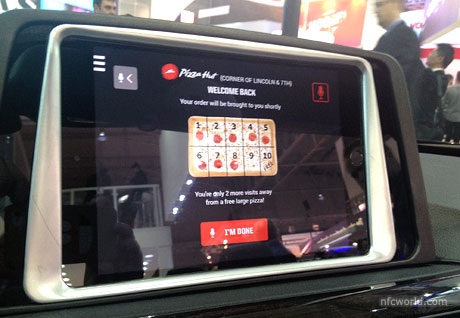
Pizza Hut is testing a proof-of-concept “connected car” system that would let its customers order and pay for pizza from their vehicle before identifying themselves when arriving at the restaurant through Bluetooth beacons placed in designated parking bays.
The restaurant chain has teamed up with Visa and Accenture to develop the service, which could also be applied to other real-world scenarios such as paying parking meters and for goods at fuel stations, Visa’s Martin Enriquez explained to NFC World during a demonstration at Mobile World Congress.
“The use case is that you want to order some food on the way home,” Enriquez, a member of Visa’s innovation and strategic partnerships team, explained during a demonstration. “You want to order food from Pizza Hut and it asks you which restaurant, and you say, ‘let’s go to this one’. You can order from the store menu option — but the most used one is going to be ‘past orders’.
“So, here is my previous order, here’s the amount, I’m going to pay with my Visa card or I can change the card if I want. We integrated [the service] with Visa Checkout; so if you put a card in Visa Checkout … you don’t need to enter your details again, you just log in.
“This goes up via cellular, because you’re on the road. It goes to the cloud, to their ecommerce site and then down to the store, on to their point-of-sale system and then they’re getting your pizza ready for you. You drive to the location and there’s a couple of parking spaces for pick up, each with a beacon, and when you park it wakes up your app automatically.
“It tells you ‘welcome back, you’ve paid and oh, by the way, you’re only two pizzas away from getting your free one’. The beacon at that stall woke up the app and triggered some activity. We collect the beacon ID and the stall number. We pass that, along with the payment information and your loyalty information and more information about the order — maybe information about the car — to them.
“In this case, we’re using Bluetooth. It could be cellular, WiFi, that’s not the point. Inside, their point of sale will now wake up and say ‘Martin’s in stall two, he’s paid, his pizza’s ready, could you bring that out to him in stall two? He’s in the BMW.’”
“I’m in the innovation group from Silicon Valley and we’ve got a very Silicon Valley approach to this,” he continued. “We said, what is an Internet of Things thing that is far along? It’s a connected car. We built three apps for the car; we built those three apps in about 10 weeks. We worked with Accenture on that so you had two big companies that were able to do that very quickly. The use cases we did were a quick service restaurant, a parking meter and a fuel station.
“So we decided to go to one of those use cases, which is the quick-serve restaurant, and make it work in real life and with partners. The Internet of Things is messy, very messy. It’s fragmented. If you look at it from an architecture point of view, there really isn’t one, there are missing pieces. What we really care about is electronic commerce.
“We don’t like cash, we want that to convert into electronic commerce. As we are looking forward, we realise that the Internet of Things is going to bring a lot of new commerce. In your experience, you just parked your car, that’s all you did. Magic happened and your pizza came out to you. That’s the beauty of technology; when you do it right, you can create a super-simple user experience.”
“It’s really not about the scale because we know we can scale,” Enriquez added. “It’s about the learning experience and getting the different perspectives from the ecosystem to identify the opportunity and try to figure out how to do this. This could happen; this is not hocus pocus five years into the future, this could be done.”
Next: Visit the NFCW Expo to find new suppliers and solutions